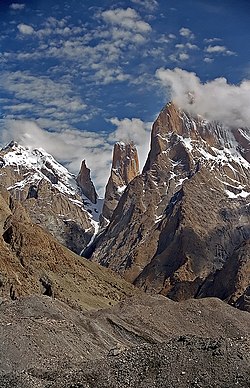Our website is made possible by displaying online advertisements to our visitors.
Please consider supporting us by disabling your ad blocker.
Cliff


A cliff is a vertical or very steep natural wall of rock.
Cliffs are common on coasts, in mountainous areas, escarpments and along rivers. Cliffs are usually formed by rock that is resistant to erosion and weathering. Sedimentary rocks most likely to form cliffs include sandstone, limestone, chalk, and dolomite. Igneous rocks such as granite and basalt also often form cliffs. An escarpment (or scarp) is a type of cliff, formed by the movement of a geologic fault, or a landslide. Cliffs are known for forming major geographical features such as waterfalls.
The tallest cliff in the solar system may be Verona Rupes, an approximately 20 km (12 mile) high cliff on Miranda, a moon of the planet Uranus. [1]
The Ordnance Survey distinguishes between cliffs (continuous line along the top edge with projections down the face) and outcrops (continuous lines along lower edge).
- ↑ "Natural world: the solar system: highest cliffs". Guinness World Records. Retrieved 2009-03-30.
Previous Page Next Page


